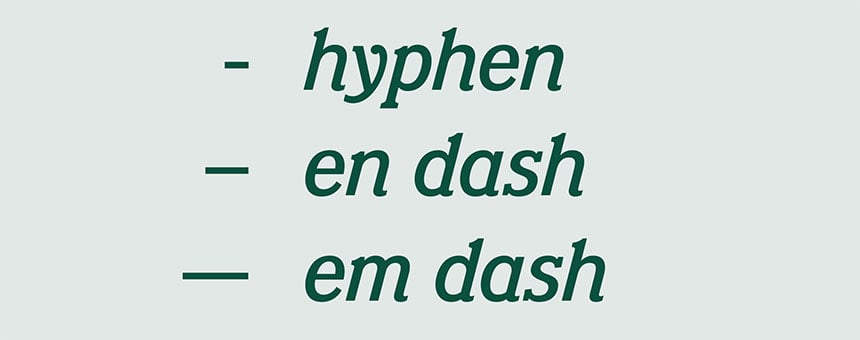
Colons can be confusing. It’s easy to go overboard with commas or parentheses. But dashes—those beautiful, thin lines that suggest a subtle pause or an abrupt change in thought—can be a smart substitute. However, not all horizontal lines are the same. If you’re not a grammar geek, you might have trouble distinguishing between hyphens, em dashes and en dashes. Here’s a guide to hyphens and dashes.

Hyphens
The hyphen, the shortest of the three, connects two or more words to form a single concept or compound modifier (e.g. re-elect, blue-green dress, last-minute call). It’s also used to separate numbers that are not inclusive, like phone numbers, reference tracking numbers and Social Security numbers.
En dashes
Longer than the hyphen, the en dash indicates an inclusive range, usually with dates, numbers, times and values. The Chicago Manual of Style says, “The en dash connects things that are related to each other by distance, as in the May–September issue of a magazine; it’s not a May-September issue, because June, July, and August are also ostensibly included in this range.”
En dashes also are used for distances that don’t involve numbers. “The LA–New York flight is a brutal, long one.”
Em dashes
The longest of the three, the em dash, is the most versatile. It can replace punctuation, such as commas, parentheses or colons, to enhance readability and draw attention to content. Used in place of commas or parentheses, the em dash adds a thought or creates emphasis:
After seeing the pages—all 40 spreads—she decided to move the deadline.
Months of hard work, late nights and editing revisions finally transformed into a finished product—the 2019 yearbook.
Em dashes may also be used instead of bullet points on lists. The Associated Press, which uses em dashes instead of bullets in their stories, recommends using periods, not semicolons, at the end of each section, whether it is a full sentence or a phrase.
Before submitting pages, editors should:
—Spell check pages.
—Double check names, grades and titles.
—Edit captions and copy.
—Review photo choices with staffers.
Multiple em dashes are used to indicate missing words: interrupted speech, unknown or unintelligible words, foul language or restricted names.

Fun aside: The Book Designer points out the often-cited origination of the em dash name is wrong. “However, the em dash—technically, a printing term—has nothing to do with the width of a capital “M,” it’s based on an entirely different and dynamic measurement: the point size of the typeface itself.” If the type is set in 10 point, the em space will be 10 points as well.

In a recent ESPN story, the em dashes are missing and back-to-back hyphens stand in their place in the second sentence of the story and the headline.
Producing em and en dashes
In word processing and design programs (like Adobe InDesign, StudioWorks+ and encore), em and en dashes can be created by hitting certain keys.
On a Mac: Shift + Option + Minus = em dash, Option + Minus = en dash
On a PC: Ctrl + Alt + Minus = em dash, Ctrl + Minus = en dash
In InDesign, you can also select em and en dashes from the Glyphs panel. Similarly in Microsoft Word, you can go to Insert>Advanced Symbol>Special Characters. Also, Word will automatically insert a dash after typing the hyphen twice. If you leave no space before or after, it will create the longer em dash. If you add spaces, it will create an en dash.
Speaking of spaces, AP Style inserts spaces before and after em dashes; CMOS and other punctuation guides do not. En dashes should never have spaces (unless you live in England and that’s a whole other punctuation and grammar discussion).

